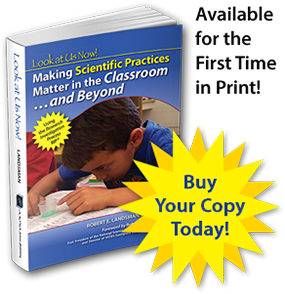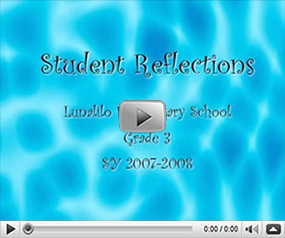The RIP® Q & A
We have compiled and answered some of the most commonly asked questions about Look at Us Now! Making Scientific Practices Matter in the Classroom...and Beyond and the Research Investigation Process (RIP®). If you have any questions that have not been addressed here, please contact us.
1. How can I use this book for my teaching?
For K-12 Classroom Teachers, Look at Us Now! Making Scientific Practices Matter in the Classroom…and Beyond can be used as a "tool book" for teachers of Kindergarten through Grade 12. Teachers can use the scenarios in each chapter as models for inquiries that can be replicated in their own classrooms. These investigations can be modified creatively to work across grade levels. For example, through actions such as incorporating math standards appropriate for a particular grade, adjusting complexity of the research design to accommodate critical thinking abilities, and/or emphasizing specific standards-based content encompassed by the inquiry, the developmental levels of the students can be addressed. The investigations described within the chapters inform teachers how they can use scientific inquiry to address all content areas (e.g., STEM, language arts, social studies, etc.), and how to introduce actions into the classroom that enable the conditions necessary for the standards to be achieved. When the scientific inquiry process is used by the teacher as described in this book, it fosters the development of critical thinking skills in the student that can be applied within and beyond the classroom.
For university level instructors/professors, Look at Us Now! can be used as a case study book for teaching methods courses. Students can be assigned chapters as case studies for analysis and reflection regarding strategies for and the use of scientific practices in the classroom. Discourse regarding how scientific inquiry invites critical thinking into teaching and learning, and discussions on how connections between meeting More Emphasis conditions led to the successful outcomes of these inquiries may be easily stimulated using each chapter as an illustration.
2. How will this book help me to apply the new standards (Next Generation Science Standards - NGSS) to my teaching?
The chapters in Look at Us Now! Making Scientific Practices Matter in the Classroom…and Beyond present examples of how scientific inquiry merges the three dimensions for the NGSS:
- Scientific and engineering practices
- Crosscutting concepts
- Disciplinary core ideas
The Framework for the NGSS and the standards themselves require that the primary mode of learning be through investigations, incorporating all three of these dimensions. This is for every grade level. Entire investigations are to be performed and integrated with selected cross cutting concepts and targeted disciplinary core ideas. Each of the teacher-narrated stories in Look at Us Now! presents one or more research investigations that illustrate how the scientific and engineering practices and crosscutting concepts are integrated with disciplinary core ideas to be learned for science and other content areas.
3. Why are the national standards' More Emphasis conditions important for my teaching?
Dr. Robert Yager’s Foreword, More Emphasis on the How vs. What, explains that the teaching More Emphasis conditions are essential for addressing any standards as they are simply good teaching practices. The teaching More Emphasis conditions guide teachers to focus on those actions and activities to introduce, continue, or eliminate in the classroom. The teacher authors in Look at Us Now! Making Scientific Practices Matter in the Classroom…and Beyond identify the More Emphasis conditions they met and the steps they took to get the rigorous outcomes they achieved.
4. Can the approach depicted in this book be used for subjects other than science?
Absolutely! The Research Investigation Process (RIP®), which is the framework for all of the investigations in Look at Us Now! Making Scientific Practices Matter in the Classroom…and Beyond, was intentionally designed by the developer as a critical thinking model to be used not only in the teaching and learning of ALL content areas, but also for developing decision making skills for application in the real world. The investigations described within the chapters of Look at Us Now! inform teachers how they can use RIP® scientific inquiry to address a variety of content areas. For example, the three investigations in Chapter 7 target content in language arts, social studies, and science. Chapter 5, 9, and 10 also present non-science investigations using the RIP®. Teachers can use this book to get ideas on how scientific inquiry practices can be brought into the classroom not only for the content of science but also for STEM and all other subject areas.
Your Shopping Cart
Ordering five (5) or more copies? Contact us for a special volume discount.
Read the Foreword
Enter your name and e-mail address below for immediate access to read the complete Foreword, written by Dr. Robert E. Yager, in its entirety.


 ANOVA Science
ANOVA Science